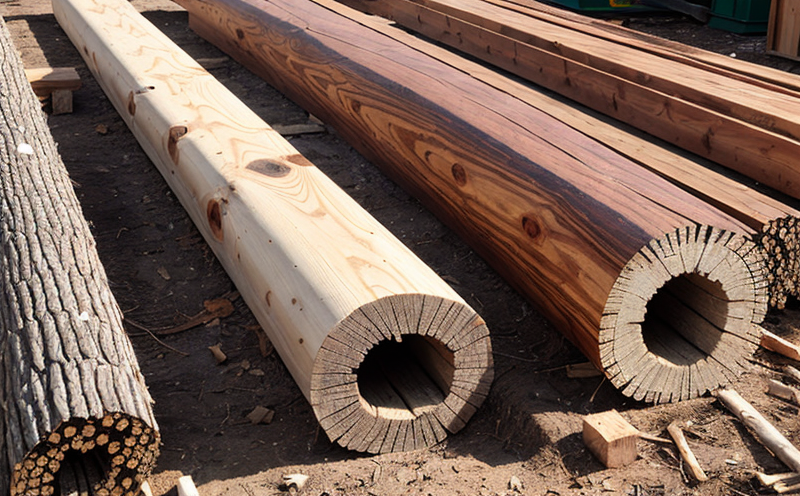ACQ (Alkaline Copper Quaternary) Treated Wood Testing
ACQ treatment is a widely used method to protect wood from decay and insect attack. The ACQ solution consists of copper, a biocide known for its efficacy against fungi and insects; ammonium salt, which acts as a buffering agent; and one or more quaternary ammonium compounds that enhance the fungicidal properties.
The primary purpose of this testing is to ensure that wood products treated with ACQ meet specific standards regarding durability and resistance. This service involves a series of tests designed to evaluate the effectiveness of the treatment, including its longevity under various environmental conditions such as humidity, temperature, and exposure to biological agents.
Our laboratory uses internationally recognized methods for testing ACQ-treated wood, including ISO 6385:1997, ASTM D2304-04(2018), and EN 350-2:2015. These standards provide a framework for determining the durability of treated wood against fungi, insects, and weathering.
Before testing begins, we carefully prepare the specimens according to the specified dimensions outlined in the relevant standards. This involves selecting representative samples that reflect the typical treatment and application methods used by manufacturers. Once prepared, these samples undergo a series of tests aimed at assessing their resistance levels.
The first step typically involves conditioning the wood samples under controlled humidity and temperature conditions to simulate real-world exposure scenarios. After conditioning, we conduct visual inspections to assess any visible changes in appearance or structural integrity due to treatment effectiveness. Next comes immersion testing where treated specimens are submerged for extended periods in water to test their resistance against moisture-related degradation.
Following this, there’s a crucial phase involving accelerated weathering tests which replicate long-term outdoor exposure conditions using artificial light sources designed specifically for such purposes. During these tests, we monitor critical parameters like color change, cracking patterns, and overall structural stability over time.
A key aspect of our testing methodology is the determination of service life predictions based on initial test results combined with historical data from similar products under comparable usage conditions. This allows us to provide accurate estimates about how long treated wood will remain effective in various applications.
| Application Area | Description |
|---|---|
| Fencing & Gates | Protecting wooden fencing and gates from decay and insect damage. |
| Barns & Outbuildings | Ensuring durability of structures like barns and outbuildings exposed to harsh weather conditions. |
| Decking & Railings | Maintaining the integrity of outdoor decking materials against moisture and pest infestations. |
Understanding these applications helps us tailor our testing approach to meet the unique challenges faced by each sector. By providing precise durability assessments, we help ensure that treated wood products perform optimally throughout their intended service lives.
Industry Applications
- Fencing & Gates: Protecting wooden fencing and gates from decay and insect damage.
- Barns & Outbuildings: Ensuring durability of structures like barns and outbuildings exposed to harsh weather conditions.
- Decking & Railings: Maintaining the integrity of outdoor decking materials against moisture and pest infestations.
The versatility of ACQ-treated wood makes it suitable for a wide range of applications across different industries. From agricultural structures to residential construction, understanding these applications is crucial in ensuring proper treatment processes are followed during manufacturing stages.
Environmental and Sustainability Contributions
Incorporating ACQ into wooden products not only enhances their lifespan but also promotes environmental sustainability by reducing waste associated with frequent replacement of damaged or decayed wood. By extending the useful life of treated materials, we contribute to minimizing deforestation and resource depletion.
Additionally, this treatment helps preserve natural resources while supporting economic growth within rural communities involved in forestry activities. Through effective preservation methods like ACQ application, we play a pivotal role in advancing sustainable practices that benefit both present generations and future ones.
The use of biocides such as copper ions found in ACQ solutions has shown promising results in reducing greenhouse gas emissions compared to conventional synthetic preservatives due to their lower toxicity levels. This contributes positively towards achieving global environmental goals set forth by organizations like the United Nations Framework Convention on Climate Change (UNFCCC).
Use Cases and Application Examples
In agriculture and forestry testing, ACQ treated wood finds application in several key areas:
- Fencing & Gates: Protecting wooden fencing and gates from decay and insect damage.
- Barns & Outbuildings: Ensuring durability of structures like barns and outbuildings exposed to harsh weather conditions.
- Decking & Railings: Maintaining the integrity of outdoor decking materials against moisture and pest infestations.
These examples illustrate how ACQ treatment can significantly enhance the performance of wooden products in various agricultural settings, thereby supporting sustainable practices and reducing resource consumption.





